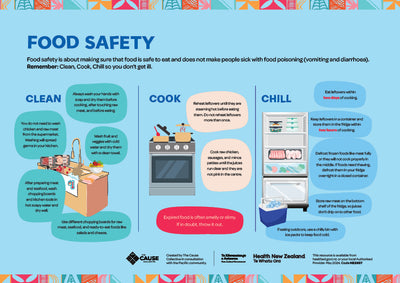Food safety English HE2657

This resource relates to the following topics:
Information on food safety, including pictures.
The full resource:
Food safety is about making sure that food is safe to eat and does not make people sick with food poisoning (vomiting and diarrhoea).
Remember: Clean, Cook, Chill so you don’t get ill.
Clean
- Always wash your hands with soap and dry them before cooking, after touching raw
meat, and before eating. - You do not need to wash chicken and raw meat from the supermarket. Washing will spread germs in your kitchen.
- Wash fruit and veggies with cold water and dry them with a clean towel.
- After preparing meat and seafood, wash chopping boards and kitchen tools in hot soapy water and dry well.
- Use different chopping boards for raw meat, seafood, and ready-to-eat foods like
salads and cheese.
Cook
- Reheat leftovers until they are steaming hot before eating them. Do not reheat leftovers more than once.
- Cook raw chicken, sausages, and mince patties until the juices run clear and they are not pink in the centre.
- Expired food is often smelly or slimy. If in doubt, throw it out.
Chill
- Eat leftovers within two days of cooking.
- Keep leftovers in a container and store them in the fridge within two hours of cooking.
- Defrost frozen foods like meat fully or they will not cook properly in the middle. If foods need thawing, defrost them in your fridge overnight in a closed container.
- Store raw meat on the bottom shelf of the fridge, so juices don’t drip on to other food.
- If eating outdoors, use a chilly bin with ice packs to keep food cold.